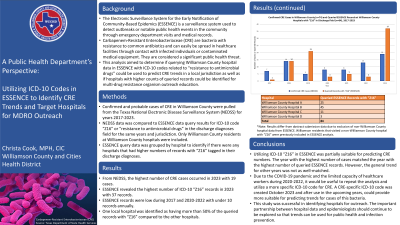Public Health and Health Policy
Category: Public Health and Health Policy
ePoster Kiosk Presentation
PHHP 110 - A Public Health Department’s Perspective: Utilizing ICD-10 Codes in ESSENCE to Identify CRE Trends and Target Hospitals for MDRO Outreach
Monday, June 3, 2024
10:16 AM - 10:45 AM CST
Location: Kiosk 1 - APIC Central, Hall 1


Christa Cook, MPH, CIC (she/her/hers)
Data Analyst and Epidemiologist
Williamson County and Cities Health District
Presenter(s)
Disclosure(s):
Christa Cook, MPH, CIC: ICU Medical: Employment (full or part time) (Ongoing), Salary (Ongoing)
Background: The Electronic Surveillance System for the Early Notification of Community-Based Epidemics (ESSENCE) is used to detect outbreaks or events in the community through medical records. This study aims to identify if ESSENCE can be used to identify trends of Carbapenem-resistant Enterobacteriaceae (CRE) cases in a local jurisdiction through querying International Statistical Classification of Diseases 10th revision (ICD-10) codes. It also looks at if local hospitals can be identified as targets for multidrug-resistant organism (MDRO) outreach by queried records.
Methods: Confirmed and probable cases of CRE were pulled from the National Electronic Disease Surveillance System (NEDSS) for years 2017-2023. NEDSS data was compared to ESSENCE data query for ICD-10 code “Z16” or “resistance to antimicrobial drugs” in the discharge diagnoses field for same years and jurisdiction. ESSENCE query data was grouped by hospital to identify if there were any hospitals that had higher numbers of patients with “Z16” tagged in their discharge diagnoses.
Results: From NEDSS, the highest number of CRE cases occurred in 2023 with 18 cases. ESSENCE revealed the highest number of ICD-10 “Z16” records in 2019 (37 records). ESSENCE records were low during 2020-2023 with under 10 records annually. One local hospital was identified as having a higher number of antimicrobial resistances in their discharge diagnoses.
Conclusions: Utilizing this ICD-10 code in ESSENCE for predicting CRE data was not suitable due to mismatched trends. However, due to the Coronavirus disease 2019 pandemic and the limited capacity of healthcare workers at that time, it would be useful to repeat the study in the future with a more specific ICD-10 code for these bacteria (created in October 2023). This study was successful in identifying hospitals for outreach and the important partnership between hospital data and epidemiologists should continue to be explored so that trends can be used for public health and infection prevention.
Learning Objectives:
- Upon completion, participant will be able to describe how ESSENCE queries using ICD-10 codes in medical records from emergency rooms and hospitals can be used to predict local case trends.
- Upon completion, participant will be able to describe how hospital data can aid public health and infection control efforts related to antimicrobial resistance.
- Upon completion, participant will be able to define two systems public health epidemiologists use to analyze, monitor and manage case data (ESSENCE and NEDSS).

